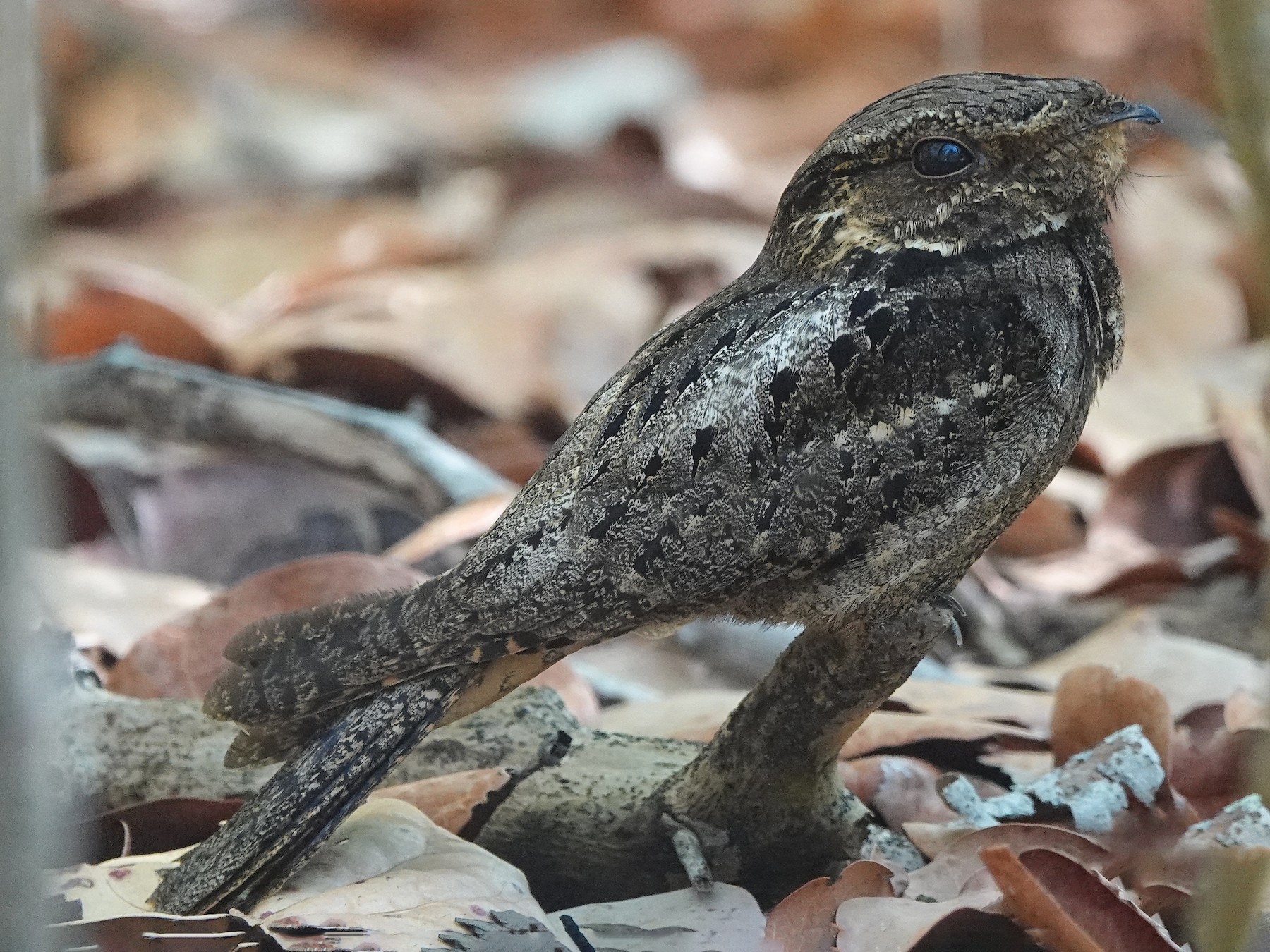Owls are known for their distinctive calls, which can be heard echoing through the night. But did you know that there are many other birds that can mimic the calls of owls? In this post, we’ll introduce you to some of the most skilled owl imitators in the bird world. From the Stellar’s Jay to the Large-tailed Nightjar, these birds have evolved to sound just like owls in order to avoid being preyed upon by them.
So come along and discover the surprising sounds of the bird world’s most accomplished owl mimics!
1. Common Nighthawk

Scientific name: Chordeiles minor
Length: 22-25 centimeters (8-9 inches)
Body mass: 55-90 grams
Wingspan: 51-61 centimeters (20-24 inches)
Lifespan: 4-9 years
Belonging to the family of the Nightjars, the Common Nighthawks are a nocturnal (at times crepuscular) species that is more commonly heard than it is seen. These nighthawks are migratory and occur in diverse habitats throughout all of northern North America, such as prairies, savannahs, forests, deserts, scrubs, and cities.
However, due to their mottled, camouflaged plumage, they aren’t easy to spot, especially during the daytime. Some of their identifying features include a deeply forked tail and distinctive white patches on their wings.
The adult Common Nighthawks are sexually monomorphic, with both sexes appearing identical in size and plumage.
What does Common Nighthawks sound like?
Common Nighthawks have a somewhat nasal voice, using which they produce a call that is a mix of whistles and clicks, and sounds strikingly similar to a hoot. A couple of long whistles are followed by 8-10 clicks.
While one can confuse them for an owl’s call from a distance, upon closer examination, you’ll notice that the nighthawk’s calls have both a higher pitch and frequency.
Besides their signature call, these nocturnal birds are also known to produce other calls, especially when they’re in flight.
2. Stellar’s Jay
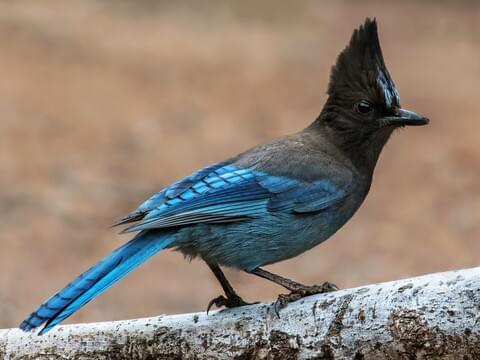
Scientific name: Cyanocitta stelleri
Length: 30-34 centimeters (11-13 inches)
Body mass: 100-140 grams
Wingspan: 44 centimeters (17.3 inches)
Lifespan: 11-16 years
Named to commemorate Georg Stellar, a Russian explorer, the Stellar’s Jays are a jay species endemic to western North America. These corvids prefer to inhabit coniferous and pine-oak forests and are also commonly found in the mountains of Central America. Many call them Long-crested Jay and Mountain Jay.
Stellar’s Jays show a lot of variation in their appearance based on their location and have over 18 recognized subspecies. The nominate subspecies have a black head and face, with a broad crest on top, white eyebrow patches, and light blue markings above their bills. Their mantle and throat are black as well, fading into a dark blue shade on their chest, belly, and rump.
The wings and tail are dark blue with black bars drawn all over them. Their eyes, bills, legs, and feet are all black, with no visible difference in the appearance of both sexes.
What do Stellar’s Jays sound like?
It’s no secret that Stellar’s Jays, much like their cousins, Blue Jays, are excellent mimics that can imitate not just the call of other birds but also chickens, squirrels, and even dogs.
While these notorious corvids are often seen mimicking owls – mostly for their own protection – Barn Owls seem to be their favorite. Despite being diurnal birds, the jays are often known to produce Barn Owl-like calls at night.
It’s fairly easy to deduce that this vocalization system is a kind of protection technique for them, seeing as owls are one of their primary predators. When they produce owl-like calls, other owls seem to respond to it, which tells them their location and helps them steer clear of it.
Although Stellar’s Jays’ calls are eerily similar to that of Barn Owls, there is a way to tell them apart: Barn Owls have a lower, rougher voice than that of Stellar’s Jay.
3. Mourning Dove
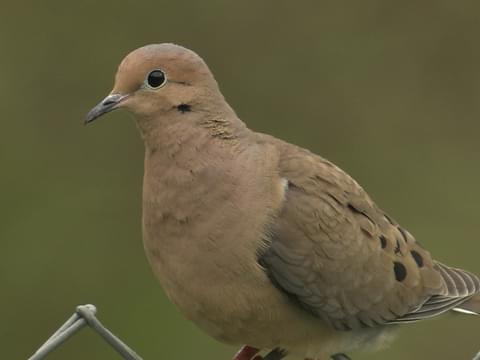
Scientific name: Zenaida macroura
Length: 23-34 centimeters (9-13 inches)
Body mass: 96-170 grams
Wingspan: 45 centimeters (17.7 inches)
Lifespan: 1-3 years
Named after their unique, doleful calls, the Mourning Doves are a dove species that has a wide range throughout all of America. These doves have five recognized subspecies and are given many colloquial names, such as Carolina Pigeon, Rain Dove, and Turtle Dove.
Mourning Doves have slender bodies with rounded heads, broad wings, and unusually long tails. The upper half of their plumage is colored pale greyish-brown, while the lower half has a pinkish tinge to it. Upon a closer look, you can also spot tiny black ear patches on their face, and several black spots scattered around their wings.
The adults of this species are almost identical, displaying little dimorphism; only the females are slightly smaller in size and appear browner. Both sexes have dark eyes and bills, with reddish legs and feet.
What do Mourning Doves sound like?
As commonly seen in many bird species, the male and female Mourning Doves produce distinct calls. And it is the male’s call that bears a resemblance to that of a certain owl; the Burrowing Owls, to be more precise.
Male Mourning Doves produce a soft, cooing call, where one long-stretched “coo” is followed by several shorter ones. They use this call both when trying to attract a mate and building a nest, more vigorously in the latter case.
Surprisingly, the male Burrowing Owls do the same; their calls are often heard while wooing a mate or defending their territory. What heightens the confusion further is that both these birds are diurnal.
There are two ways you can tell their calls apart:
• Mourning Doves have a softer, low-pitched call than Burrowing Owl’s high-pitched calls.
• The doves often coo in large groups, which is highly uncommon for the owls.
4. Chuck-Will’s-Widow
Scientific name: Antrostomus carolinensis
Length: 28-32 centimeters (11-12 inches)
Body mass: 66-188 grams
Wingspan: 58-61 centimeters (22-24 inches)
Lifespan: 13-15 years
Another member of the Nightjar family, the Chuck-Will’s-Widows are a near-threatened nocturnal bird species of the Americas. These migratory birds breed in the rocky uplands and pine woodlands of North America and travel south to Central and South America during the winters.
These nightjars have been named after their distinctive song and have a typical nightjar appearance. Their bills are short, and tails are long, with a deeply mottled overall plumage. They have a reddish-brown head and back, with a buff throat and darker underparts.
Both sexes of this species look identical, except for the white tail patches that only the males possess.
Did you know? The Chuck-Will’s-Widows are the largest nightjars found in all of North America.
What do Chuck-Will’s-Widows sound like?
Chuck-Will’s-Widows are another nocturnal birds whose calls are mistaken for that of the Great Horned Owls. Their mating calls sound just like the hoots of these owls; they begin their song with one low-note call, followed by several others in rapid succession.
When you hear their mating calls at night, the rhythm will certainly convince you that it’s an owl making those sounds. However, if you’ve heard enough Great Horned Owl calls, you’ll be able to tell how these calls have a higher pitch than that of the owls.
5. Band-tailed Pigeon
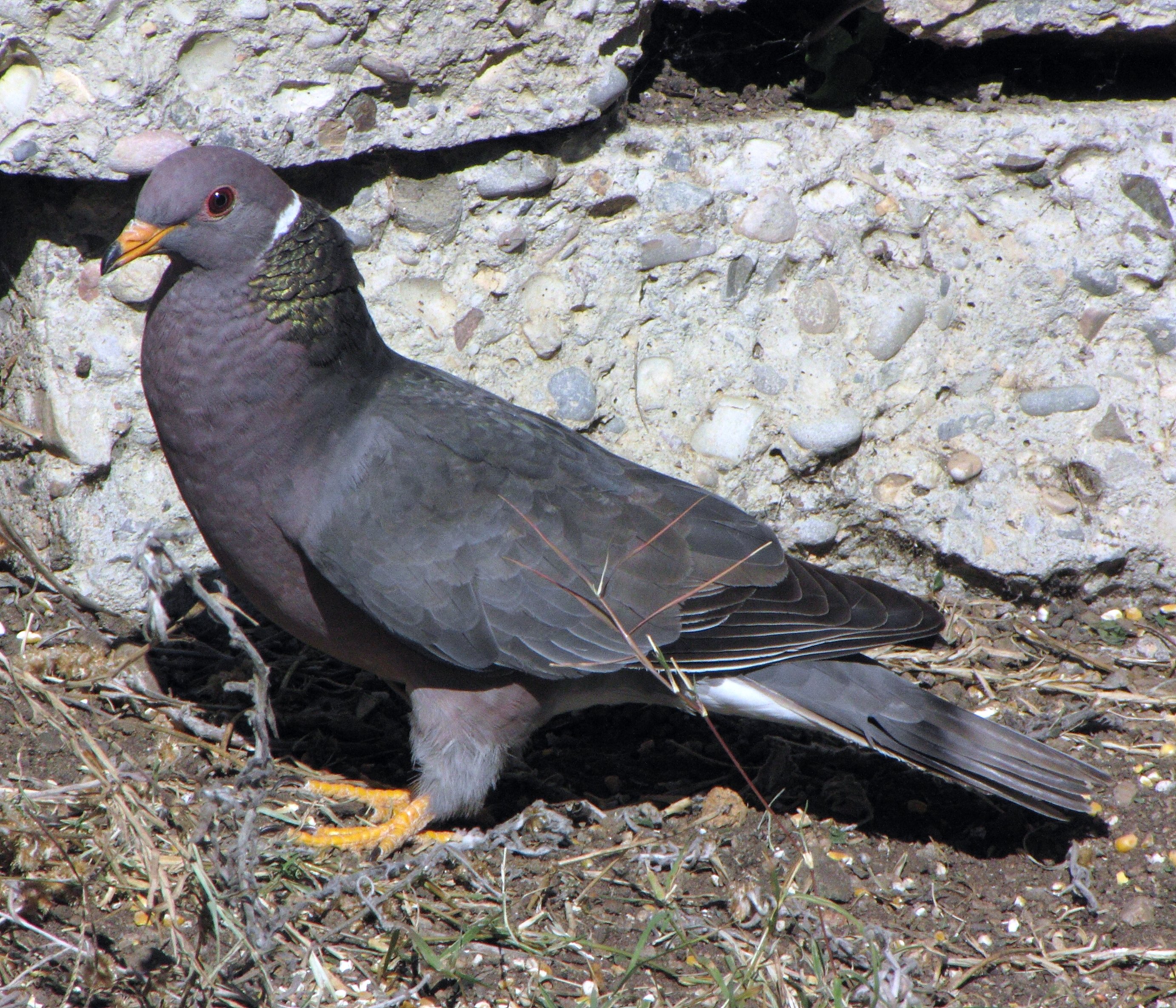
Scientific name: Patagioenas fasciata
Length: 36-38 centimeters (14-15 inches)
Body mass: 320-350 grams
Wingspan: 66 centimeters (26 inches)
Lifespan: 20-22 years
The largest pigeon species in entire North America, Band-tailed Pigeons are a pigeon species that primarily inhabit the coniferous, oak, and pine-oak forests. They’re a migratory species and have over eight subspecies.
Much like the other pigeons of the Patagioenas genus, Band-tailed Pigeons also possess iridescent feathers on their neck and a terminal tail band. Their overall plumage is grey, with the upper parts darker than the underparts. You can also notice a faint pinkish cast on their head and neck.
These pigeons have white ear patches on their face, a white belly, and a pale band on their tails. Their eyes are dark and have red eye rings; the feet are yellow, and so are the bills, except for a greyish tip.
What do Band-tailed Pigeons sound like?
Although the signature calls of Band-tailed Pigeons consist of grunts and chirps, they’re also known to coo and hoot. Cooing is commonly heard from the females of this species when they’re either trying to attract a mate or are tending to their fledgling. This call is confused with that of the Burrowing Owls during the daytime.
Furthermore, male Band-tailed Pigeons are known to produce hooting calls that are strikingly similar to the hoots of night owls. Only their calls are heard during day time, unlike the latter.
6. Wilson’s Snipe

Scientific name: Gallinago delicata
Length: 23-28 centimeters (9-11 inches)
Body mass: 79-146 grams
Wingspan: 41-44 centimeters (16-17 inches)
Lifespan: 10-12 years
Named to commemorate the American ornithologist Alexander Wilson, the Wilson’s Snipes are a North American shorebird that was once considered to be a subspecies of the Common Snipe.
These migratory birds inhabit the bogs, tundra, and marshes of North America and travel to South America and the Caribbean during winter. You can also find them on the Chukchi Peninsula in Russia.
Wilson Snipes are long-legged birds with a long, dark beak, mottled brown plumage, and white bellies. Distinctive dark stripes run above their eyes, and their wings are long and pointed. Both sexes of this species have identical plumages and display no dimorphism.
What do Wilson’s Snipes sound like?
Although Wilson’s Snipes are coastal birds and are rarely found around the deeply wooded habitats of owls, their calls bear a resemblance to that of one owl species: the Screech Owls.
While these snipes have long-drawn, high-pitched chirping calls, during their mating season, the males produce a distinct winnowing sound. This sound, produced during their flight performances, is known to attract them a mate.
And even though the female snipes would never confuse it with another bird, to our ears, the winnowing is eerily similar to the calls of the Boreal Owls. Thankfully, the Boreal Owls are nocturnal, unlike the diurnal snipes, leaving little room for their calls to coincide.
7. Rock Pigeon
Scientific name: Columba livia
Length: 30-36 centimeters (11-14 inches)
Body mass: 265-380 grams
Wingspan: 50-67 centimeters (19-26 inches)
Lifespan: 6 years
Also referred to as Rock Doves, the Rock Pigeons are the ancestral species of the Domestic Pigeons, which are considered to be the oldest domesticated birds in the history of mankind.
The most widespread pigeon species in the entire world, these birds are endemic to North Africa, western Asia, and Europe, and have an introduced population elsewhere. They can be found in almost every open and semi-open habitat in the world but prefer to roost on cliffs and rock ledges.
While Rock Pigeons have over 12 subspecies, all of them have almost identical physical features, such as iridescent neck feathers, grey bills with a white cere on top, two dark wing bars on each wing, and reddish-pink feet.
Both sexes will appear identical at first glance; upon closer look, you’ll notice how the neck feathers of the females have a duller sheen than that of their male counterparts.
What do Rock Pigeons sound like?
Rock Pigeons, which are common prey for most owl species, also happens to sound like them! These passerine birds produce not one but two calls that are just like that of the owls.
The first, and more common call is their constant cooing, which is produced both individually and in groups. This call will remind you of the Burrowing Owl’s calls.
Another call that the Rock Pigeons produce is a distinct “hoo-hoo.” You’ll only hear them making this sound during dusk or dawn when they’re either about to roost or just waking up. This call, combined with the odd hour in which you hear it, are both indications of the Great Horned Owls.
8. Eastern Whip-Poor-Wills
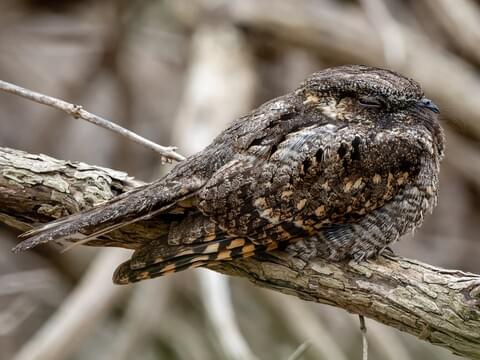
Scientific name: Antrostomus vociferus
Length: 22-26 centimeters (8.7-10.2 inches)
Body mass: 43-64 grams
Wingspan: 45-48 centimeters (17-18 inches)
Lifespan: 13-15 years
Named after their signature song, the Eastern Whip-Poor-Wills are a nightjar species that breed in the eastern United States and migrate to the country’s western regions, as well as to eastern Mexico, during winters.
Just like the other nightjar species, Eastern Whip-Poor-Wills also have dark, mottled plumage. Their upperbody is a blend of grey, brown, and black, while the underparts are mainly greyish-black.
Both sexes of the species appear almost identical, with only two visible differences. The males have white throat patches and tail tips, while the females have brown ones.
What do Eastern Whip-Poor-Wills sound like?
As many of you might already know, Whip-Poor-Wills have a whistling signature call that sounds very much like their own name. Do you know which owl’s calls bear a resemblance to them? It’s the Spotted Owl.
Known for producing a variety of as many as 13 different calls, these owls produce a distinct whistling call around dusk which sounds eerily similar to that of the Eastern Whip-Poor-Wills.
9. Large-tailed Nightjar
Scientific name: Caprimulgus macrurus
Length: 25-29 centimeters (9.8-11.4 inches)
Body mass: 54-79 grams
Lifespan: 5-7 years
The Large-tailed Nightjars are a nightjar species with a widespread distribution throughout Southeast Asia and western Australia. These nocturnal birds have six subspecies and primarily inhabit the lowland, montane, and mangrove forests within their range.
While Large-tailed Nightjars have a dark mottled plumage typical of the nightjars, the distinctive feature that sets them apart from the other nightjars is their tail.
They have long, broad tail which is pale brown in color. Their head and upper parts are greyish-brown and covered in dark streaks, with a slightly paler underbody. Their bills are short, with long, pointed wings. Both sexes appear identical.
What do Large-tailed Nightjars sound like?
Because Western Nightjars are nocturnal birds, just like most owls, both their calls are heard around the same time. They have low-pitched croaking calls that can sound similar to the calls of Marsh Owls.
Both these birds have an irregular series of croaks they use as their signature call. The only difference is, while the nightjars’ croaks are hollow, that of the Marsh Owls are deep and low-pitched.
10. Tawny Frogmouth
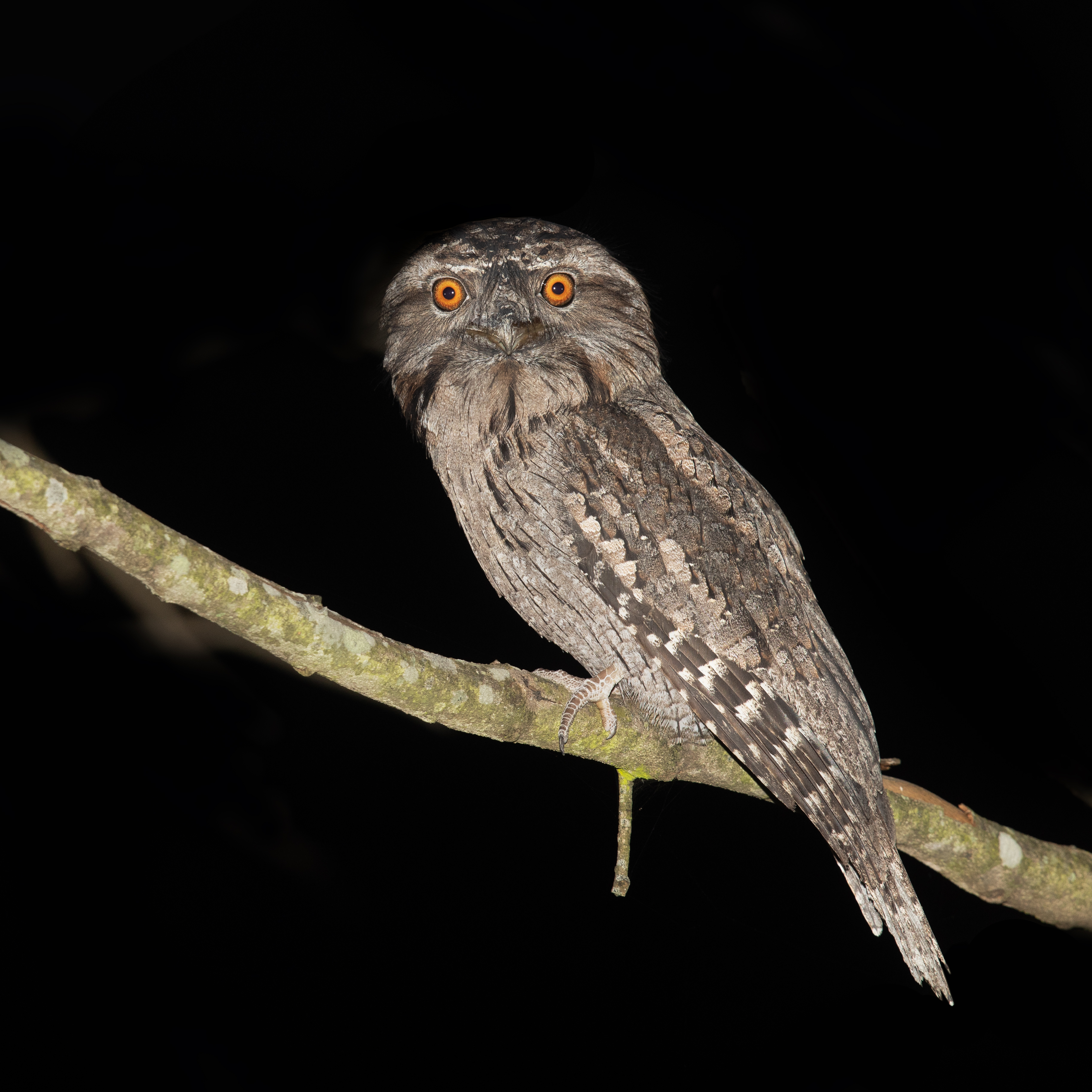
Scientific name: Podargus strigoides
Length: 35-53 centimeters (13-20 inches)
Body mass: 200-650 grams
Wingspan: 65-98 centimeters (25-38 inches)
Lifespan: 10-14 years
The Tawny Frogmouths are a large-headed frogmouth species endemic to the forests, woodlands, and savannahs of mainland Australia. These nocturnal birds might have more in common with owls in terms of appearance, but they’re more closely related to the nightjars.
Tawny Frogmouths are stocky-bodied birds with short legs and rounded wings. Their hooked bills are wide and heavy, while the irises are bright orange.
They occur in three color morphs, among which the grey-morphed birds are most commonly found. The females are known to have darker plumage than their male counterparts.
What do Tawny Frogmouths sound like?
While Tawny Frogmouths do have an appearance quite similar to that of the owls, when it comes to vocalization, they’re not all that similar.
These frogmouths are not widely vocal in the first place. They’re more of the silent kind and will generally hiss or buzz when disturbed or attacked.
Their signature call consists of a series of low-pitched “oooom-oooom-oooom,” which might sound like the short hoots of the Grey Owls when heard from a distance.
Related articles:
20 Beautiful Birds in Indonesia to Marvel at


